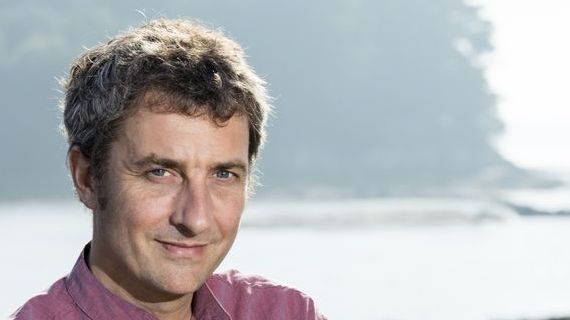Interview with Guillaume Verdier: I’ll never be someone’s boss
Since 2000, Guillaume Verdier’s name has become synonymous with competitive sailing. Ultim, America’s Cup, Imoca, Class40, Mini… Dozens of winning boats bear his signature. A success he doesn’t want to take credit for. Voiles et Voiliers met the architect at his home in Larmor-Baden, where he takes advantage of the calm of this natural setting to develop the world’s fastest boats.
Voiles et Voiliers: America’s Cup, Ultim, Imoca, Class40, land-based sailing world records… Your signature is everywhere. Are you in great demand?
Guillaume Verdier: Actually, it’s always a bit the same to work for a sand yacht or a fishing boat. We have a method of talking to people to find out what they want, and we adapt it with physics. Maybe our working method is special. I don’t work much on the America’s Cup any more. I’m still part of the Team New Zealand, but I didn’t want to do another edition. I’d reached saturation point after 4 or 5 campaigns. I had too much work to do with 12 60-foot boats, 100-foot boats, Class40s… It was a lot to manage on top of the America’s Cup, which is almost a full-time job. I had to take a break.
Voiles et Voiliers: The team you work with, have you been building it up for a long time?
Guillaume Verdier: Yes, it’s still the same people, but it’s grown a bit. In the beginning, I was on my own and started working on Yves Parlier’s hydroplane. That’s when the team was formed. We also worked together on the French Areva challenge for the Cup, then continued with Team New Zealand, who asked me to bring my team. Today, for each project, there are between 5 and 12 of us. There’s Romaric Neyhousser who designs the boats, Loïc Goepfert, Véronique Soulé and Romain Garo who work on performance, as well as Robert Kleinschmit on analysis, Benjamin Muyl and his team with whom we also worked on the ETNZ land speed record prao. We have a team focusing on fluid calculations, and another dealing with structural calculations, based in New Zealand. Hervé Penfornis, Erwan Tymen and Jérémie Palmer take care of methods and project follow-up, and there’s also Morgane Schlumberger who manages boat stability and plans. In fact, there are quite a few of us, and everyone gets along well. Nobody works in my office. They have a certain freedom to live as they wish and also to work on their own account and in their own name. Sometimes it takes us a while to get projects off the ground, but once it’s going, everyone knows where they’re going.
I didn’t want to have a boss anymore, and I told myself that I would never be someone else’s boss.
Voiles et Voiliers: From the outset, you decided not to build a “classic” architectural practice with employees in an office…
Guillaume Verdier: After my studies, I worked with Groupe Finot for 5 years. I had designed a lot of 60-foot open boats with Pascal Conq, with whom I loved working. I was self-employed, but I was a bit like an office worker. At some point, I couldn’t take it anymore. I didn’t want to have a boss anymore, and I told myself that I would never be someone else’s boss. It’s not that things didn’t work out, but I find that there’s no need to be authoritarian or pyramid-shaped. Small, horizontal structures are really great.
Voiles et Voiliers: What made you want to become a naval architect?
Guillaume Verdier: It’s very simple, when I was young, I sailed in a sailing camp in Brest. I was 8, and my sailing instructor told me he was going to go to a boat design school in England. I’d kept that in mind, and when I started Math Sup in France – I didn’t really like it – I remembered that there was a school for designing sailboats. It was Southampton.
You have to lose to be able to learn.
Voiles et Voiliers: In the end, you are often in competition with other design firms…
Guillaume Verdier: Yes, designing for competition boats inevitably means having to compete, and it would be a shame not to. When I worked at Finot, we designed boats for the BOC Challenge, then the Vendée Globe, but we had almost no competition. It wasn’t great. You have to lose to learn. You can’t win all the time. The wheel will turn, and we won’t be the ones winning all the time.
Voiles et Voiliers: Are there any projects you regret not having been able to do?
Guillaume Verdier: Yes, because you can’t do everything. For example, I get on well with Banque Populaire, and I would have liked to design the Banque Populaire trimaran, but I was committed to Gitana, and I promised them I wouldn’t do another one. We’re still friends with Ronan Lucas, and if their boat goes faster, that’ll be great.
A sailboat can go around the globe in 42 jours. There is no gasoline-powered boat capable of doing that.
Voiles et Voiliers: Can sailing really play a role in decarbonizing maritime transport?
Guillaume Verdier: I think that’s the only point of what we do when we design racing boats. You could say that a sailboat isn’t easy to build, but it’s inspiring for people to see that a sailboat can sail around the world in 42 days. There’s no gasoline-powered boat capable of doing that in 42 days. It would have to carry its own fuel, so it couldn’t go fast enough. If people don’t realize that, I don’t know what they need. It doesn’t matter if one or other of our boats wins, but if it raises awareness that we can get around with wind, solar panels, without oil, that’s a good thing.
Voiles et Voiliers: Is it important for you to think about environmental impact?
Guillaume Verdier: Yes, it’s important. I think the Vendée Globe should take a more directive approach to the subject. It wouldn’t be very complicated to ask the skippers to set off without oil, just with 30 liters of sealed petrol. I’d find that more demonstrative. It’s a pity that old boats can’t race anymore. I understand the ban on “garbage” boats, but they should set a certification level instead, and require that the “honeycomb” be replaced in certain areas, that they be updated, because these boats aren’t screwed up. It would be great if we could keep the racing boats, if we were forced to rehabilitate them and if there were, for example, compensated time rules.
Voiles et Voiliers: Especially since, for an architect, rehabilitating a boat can be an exciting job?
Guillaume Verdier: Yes, we did Pip Hare’s (Medallia) and Giancarlo Pedote’s (Prysmian). These are boats we designed with VPLP. These are major refits, almost as demanding as designing a new boat. Often, what we’re asked to do is the keel area: what a mess!



